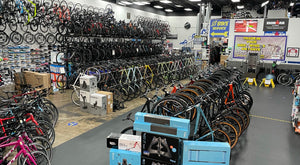
Physiology of Triathlon
Physiology of Triathlon
One of the great joys of being a coach and an athlete in the Playtri system is knowing that our coaching philosophy has a long history of success informed by scientific research and in-house performance testing and experience. If you weren’t able to attend my February 4th clinic on the Physiology of Triathlon or the Facebook Live - feed kept dropping (Sorry about that! I’m not sure why that kept happening), then this is a good overview of what we talked about.
Many of you probably know that Playtri is the official bike shop of Ironman branded races in the US and also USA Triathlon. Not a day goes by that I don’t get excited about coaching the whole athlete, from bike fit to finish line. But what you may not know is that Playtri started over 23 years ago as a coaching company. The bikes, shoes, wetsuits, and other equipment we carry are selected because we believe they are the best for you to pursue your fitness and health goals. And that coaching philosophy has a deep grounding in understanding how the body works.
As a Playtri coach, I believe that it is incredibly helpful for athletes to understand how their body makes energy to do what they want to do and so here is an overview of how your body produces energy, how testing and coaching can help you maximize your energy production and usage, and how this will ultimately make you a better and faster endurance athlete.
Your body converts the chemical properties of food into adenosine triphosate (ATP) from food into energy your body can use. No matter what your body is doing, you are using ATP to function. And you have two energy systems (three energy subsystems) that create ATP. There is the aerobic system and the anaerobic system. The aerobic system uses oxygen to convert carbohydrates, fats, and occasionally proteins from food into ATP and is the primary system that endurance athletes and the system you use in your daily functions. The anaerobic system is a secondary system used by endurance athletes, and uses no-oxygen chemical processes to create ATP, and is used primarily for shorter duration and intense efforts. Which energy system your body prioritizes in sport is dependent upon exercise intensity and duration, but primarily intensity. Understand that at no time during rest or exercise does your body rely solely on one energy system to provide the complete supply of energy your body needs.
Within the anaerobic system there are two subsystems called the phosphagen and the anaerobic glycolysis systems. Very simply, the phosphagen system does not require oxygen but relies on chemical reactions of ATP and creatine phosphate (CP) to provide energy at a high rate. This system is used primarily for very short-duration, high-intensity exercise and is the first energy system that your body taps into. ATP and CP are stored mostly in fast twitch muscle fibers in low amounts and thus gives you fast energy for a short amount of time; think 10 second sprints with long recovery (approximately 3-8 minutes) or the get up and go speed at the beginning of a mass start swim in a draft legal triathlon. In less intense and longer efforts, this phosphagen system produces very minimal ATP.
The anaerobic glycolysis system again does not rely on oxygen and provides ATP for 1-3 minutes. This system primarily uses carbohydrates as fuel and the end product of this energy system is lactate. You may have heard that lactate (often referred to as “lactic acid”) is bad, but in reality, it isn’t bad at all. Lactate can be used as an energy source. Lactate is often labeled as “bad” because when the body produces more lactate that it can convert back into ATP, we start to have acidic build up in the muscles. So once the lactate builds up in the muscles, we need to slow down and recover.
The final subsystem is the oxidative or aerobic system. This system uses oxygen to convert carbs (glucose/glycogen), fat (fatty acids) or protein (amino acids) into ATP. Protein is not metabolized in high amounts and generally is not a concern for endurance athletes unless they are doing ultra-distance events of 24+ hours. This oxidative/aerobic system is the primary source of energy during rest and lower intensity, longer duration exercise.
Why is this important? Because as endurance athletes we rely primarily on the oxidative/aerobic system, but as time-crunched age group athletes we want to get faster, so we spend more time in the anaerobic glycolysis system. Instead of building up fatigue in our muscles from long, low intensity aerobic exercise, we build up fatigue from acidic build up in our muscles. If you do this, you may see short-term gains, but ultimately this can lead to injury, burn out, or overtraining; all three being detrimental to improving as an athlete.
So how does Playtri coaching use this physiological information? Simply, we test and we work individually with our athletes to improve their skills and approach. We have all our individually coached athletes do blood lactate testing for the bike and the run using our proprietary in-house testing protocol and analysis, so that we can prescribe our athletes specific workouts that will help them to improve their aerobic engine. Some of those workouts will target aerobic power improvement (how fast you can produce energy using the aerobic system), while others will target aerobic capacity improvement (how much energy you can produce using the aerobic system). And we work one-on-one with our athletes to make technical and technique improvements that will help that gain advantages come race day.
If you have questions about anything this article or are interested in learning about different coaching options, please reach out to me at jim.rowe@playtri.com. Happy training and racing this year!
Jim Rowe is a Playtri Level 4 Coach and Coach Education Lead, a USAT LI Certified Coach, and NASM Certified Personal Trainer who works with adult athletes of all abilities from beginners to IRONMAN World Championship qualifiers. Learn more about Jim at www.playtri.com/jim-rowe.



